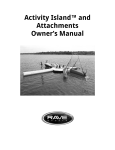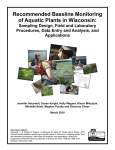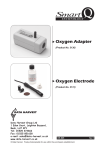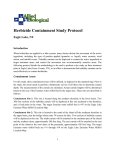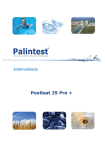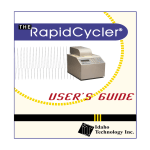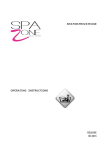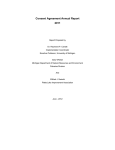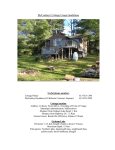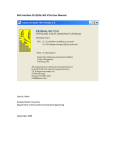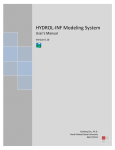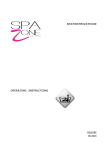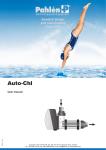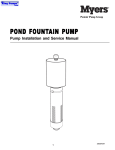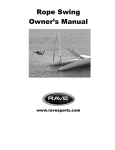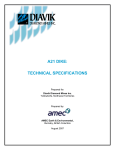Download POND MANAGEMENT
Transcript
POND MANAGEMENT An In-depth Response to Frequently Asked Questions from Pond Owners And Managers Created by Michael Gaden, MSU Extension Natural Resources Agent, Livingston County, 2004 Reviewer and contributor, Donald Garling, MSU Department of Fisheries and Wildlife Small ponds ranging from a quarter to a few acres in size are abundant in many parts of Michigan, both naturally occurring and constructed. Management of a pond is based on the purposes of the pond, whether it is for fishing, wildlife, swimming, aesthetics, or other purposes. Managing a pond challenges the owner or manager to maintain a particular condition in a situation in which the pond is in a continual process of succession. Or, one might choose to leave the pond alone and let nature take its course. Below are questions and responses based on the many inquiries from pond owners and managers on such topics as managing aquatic plant populations, fish stocking, pond construction, and general pond maintenance. TABLE OF CONTENTS SUBJECT PAGE Pond Construction, General Management, Improvement General Pond Management.…………………………………… Pond Construction….…………………………………………. Dredging.……………………………………………………… Bank Stabilization.……………………………………………. Pond Liners……………………………………………………. Sedimentation, muck, sludge………………………………….. 3 4 5 6 6 6 Water Supply and Levels.......................................... 6 Water Quality and Testing Water Water Quality………………………………………………….. Testing Water………………………………………………….. 7 8 Pond Aeration............................................................. 8 Management of Aquatic Vegetation & Algae Plants…………………………………………………………... Purple Loosestrife and Other Nuisance Shoreline Plants……... Algae…………………………………………………………… Herbicides, Algaecides, and Dyes……………………………… 9 12 12 13 Fish and Fish Management.............................................. 15 Wildlife...................................................................... 18 References................................................................ 20 Pond Construction, General Management, Improvement General Management Q. Do we need someone to come look at the pond for the best advice? A. You can learn much from books and online resources. Additionally, there are many free local resources available that can provide various types of pond management and aquatic ecology information, such as MSU Extension, Michigan Department of Natural Resources, Soil Conservation Districts, watershed councils, and more. However, onsite visits by these resources are often not available. For site-specific professional services and professional results, hire an aquatic consultant. Q. What regular maintenance do excavated ponds require? Best long-term management: (also applies to natural ponds) • • • • • • • • • • Reduce nutrient loading to pond! Keep landscape disturbance to a minimum in a pond’s drainage basin Avoid soil erosion Do not connect ponds to storm drains Divert local runoff away from ponds with berms and ditches Keep a buffer strip of vegetation around as much of the pond as possible, so as to intercept local runoff. Vegetation will also catch windblown leaves and other debris. Discontinue turfgrass fertilization within at least 20 feet from pond. If you need to fertilize choose a phosphorus-free fertilizer, i.e. 19-0-19 Keep livestock out of the water Construct a settling pond or a wetland to receive runoff and drainage before it reaches the pond Check hidden sources such as septic systems or drainage tiles Q. What can we do for our pond, or avoid doing, to help preserve and/or improve the environment? A. Keep out pollutants. Manage it to attract wildlife. Try to maintain good water quality. Keep out exotic species. Also refer to “Best long-term management” above. Q. How do we manage our pond to make it swimmable. A. Blue pond dye can help keep weeds down. Dredging so that the pond bottom is beyond the photic zone will also prevent plant growth. Removing organic debris, including leaves, dead aquatic vegetation, and sedimentation from runoff or erosion will help reduce a mucky bottom. A side slope of 3:1 will reduce plant growth along the banks. Preventing algal growth by keeping out excessive nutrients from runoff. An aerator or fountain might push duckweed and floating algae away from swimming area, add oxygen to the water, and keep the water from being stagnant. Removing habitat for turtles, and other forms of wildlife that are not desired in a swimming area. This pond is not conducive for wildlife habitat. We often joke that you should also cover the bottom and sides with cement! Q. How can I keep a sand area for swimming? A. This would require small-scale site maintenance. Because of the small size of the area to be treated control tools typically used are small harvesting devices, such as hand-held rakes. Raking, like cutting turfgrass, will likely need to be repeated throughout the season as the plants grow. Sand beaches are typically not natural situations along ponds and inland lakes due to soil types, lack of pounding waves, and other factors. Therefore the pond will typically try to grow plants and will accumulate sediment and/or muck as a normal part of pond succession. The existence of sand will be based on the existing soil type, or whether sand is brought in to create an artificial beach. Placing sand over a muck soil without a porous liner, may result in the sand sinking into the muck soil. Q. I would like my pond to be as natural as possible. What are the best ways to control growth and keep it natural? A. “Natural” is a relative term ranging in meaning from one person to another. For example, “natural” could mean ecologically healthy to one person, or untouched by humans to another person. Unless a pond is very remote and pristine, it likely has been disturbed by humans in one way or another. Runoff carrying sediments and nutrients is one of the biggest disturbances. Keeping the pond natural is not as much managing without chemicals as it is trying to keep plants, animals, and water chemistry in balance. Animals need proper habitat, both in the water and on shore. Native landscaping around the shoreline will provide a protective buffer zone that will help to filter sediments and nutrients, as well as habitat for wildlife. Using chemicals properly can aid in keeping aquatic vegetation at moderated levels. Keeping nutrients at low levels will help maintain lower amounts of vegetation. A pond dredged or dug 15 feet or more will likely be a healthier pond (shallower ponds often take on the characteristics of a wetland rather than a pond or lake). Controlling weeds physically or mechanically is another option other than using chemicals. Pond Construction Q. Am interested in building 1/2 to 1 acre pond. What are the prices of digging a pond? A. You need to check with an excavator for prices. Prices might vary based on location, soil type, and other factors. Q. I am having a pond dug that will be 100 x 150 feet. It will have a 3:1 slope on all sides to 6 feet deep then straight down to 15 feet deep. The soil is clay. A. You may want to reconsider the changing slope at 6 feet if tall people may swim in the pond. Drowning occurs in quarry ponds that have steep cutoffs because people may panic when they can’t touch bottom. The cutoff may also be in water that is less than 6 feet deep if the pond does not fill to the expected level or during draught conditions. Q. Should I have some section dug deeper than 15 feet? A. For fish ponds in Michigan you want the depth to be at least 12-15 feet throughout as much of the pond as possible, but at least a quarter of the pond bed. This helps avoid winter and summer oxygen depletion and resultant stress on fish, which can end in poor growth or mass die-off. Having parts of the pond as deep as 25 feet would be even better if possible. Deeper than 25 feet has shown no results as to providing benefits to fish populations. If maintaining fish populations is not your goal then depth is not as much a factor. Wildlife ponds can be shallow relative to fish ponds. Dredging Q. Can you dredge an existing pond to make it deeper? How effective is dredging? A. Dredging a pond can reduce aquatic vegetation by lowering the pond bed below the photic zone. The right depth is based on water clarity and how deep sunlight penetrates. Depths of 18 feet or more should reduce or eliminate all nuisance plant growth. Dredging can also create steeper side slopes on which plants seem to grow poorly. Deeper ponds are more suitable for fish. Deepening a pond can also help the pond deal with nutrient loading. Keep in mind that dredging may require a permit from the DEQ or from your local government. Permits may also be required for disposal of the removed materials, or spoils. A state permit is required for dredging if the pond is considered to be part of a wetland that exceeds 5 acres or is connected to wetlands by creeks or streams. Local permits are required by some townships for wetlands as small as 1 acre or may be required for any pond building or renovation project. Check with your local and state authorities before you start to dig. Q. Does dredging/raking really help? A. If dredging your pond beyond the photic zone to reduce plant growth is what you desire, than dredging will help. If dredging to 15 feet or more to improve fish habitat is what you desire, than dredging will help. If raking an area where plants interfere with human uses of the pond is what you desire, than raking will help. If reducing pond vegetation without the use of chemicals is your goal, than raking could be one solution. Q. Dredging -Is it successful? What is involved? Long-term effects? A. Long-term effects of dredging should be a reduction in aquatic vegetation if the depth is beyond the photic zone. Dredging can also remove muck and sediment during the process, as well as provide a better habitat for fish. Dredging, however, only treats symptoms of excessive plant and algae growth, rather than the cause, which is excessive nutrient loading, usually through runoff. Ultimately you want to use the advice as presented in “Best long-term management” at the beginning of this document. Finally, dredging is an expensive operation. Costs for removing 2 to 5 feet of sediment per acre could range anywhere from $15,000 to $80,000 depending on conditions. Check locally for more accurate quotes. Q. How often should it be dredged? A. Dredging is not typically routine maintenance, unless the pond fills in rapidly. But dredging can be extremely expensive, and the pond environment will be disturbed for a couple years at least each time the pond is dredged. All-in-all it would be based on the overall function of the pond, weather it be for wildlife, swimming, irrigation, etc., and if the disturbance of routine dredging is going to effect the function or value of the pond. It may also be desirable to build a shallow settling pond that intercepts heavy sediment loads in runoff that is easily accessible for dredging equipment to reduce the costs of repeated dredging of a larger pond. Bank Stabilization Q. How do you keep the sides from collapsing, especially is the sides are mostly sand? A. You need to stabilize the sides with vegetation and perhaps bioengineering. Bioengineering is the use of organic or inorganic materials combined with plants to create stabilization of the bank. If the sand is a beach type situation, and if the beach is not a natural beach, then it might be very difficult to keep the sand in place. If you’re just talking about naturally sandy pond banks, the stabilization and/or bioengineering will be required. Pondliners Q. What are the benefits of a pondliner? A. Covering bottom sediments with black plastic, landscape fabric or other light prevention materials can be useful in small scale situations for controlling submersed weeds. Several bottom-covering materials are commercially available. They are all called benthic barriers. The best benthic barrier is gas permeable and opaque and cannot be penetrated by plant roots or vegetation. Various types of pondliners are also used to keep water in the pond if a clay barrier is not available. Sedimentation, Muck, Sludge Q. The bottom of my pond is very “mucky”. Can I (should I) try to do something about it? If so, what? A. Removal of the sediment through dredging is the only guaranteed method. However this does not resolve the cause of the muck, which could be due to nutrient levels, sedimentation through runoff, and/or organic materials such as decaying plants and leaves. Bacteria and enzyme products are advertised to attack the cause of pond odor, ammonia and slow-decaying matter, as well as degrade accumulated organic waste or sludge. I cannot guarantee the results of these products, as they are not registered by EPA or backed up by research. They would be a gamble to use. Q. How do you firm up the bottom? A. If you have muck, the only way to firm it up is to eliminate it. The only proven removal method is dredging. Q. What causes floating patches of mud? A. I can only imagine this would be algae. Follow the guidelines for treating for algae. Water Supply and Levels Q. How do I maintain an adequate water supply? A. Water levels will flux, especially for ponds that get their water from groundwater. Pond levels can often be controlled if coming from a stream or springs, especially if using a dam. Be sure to check with the Michigan DEQ for permit requirements and regulations. Water can be pumped in from a well, but this could become expensive and require maintenance. The amount of water pumped will have to exceed the amount lost by evaporation and seepage, which may be difficult during hot summers under draught conditions. Q. How low could the water level drop in the summer before the fish would be in danger? A. It would depend on the water temperature, the amount of dissolved oxygen, the amount of aquatic vegetation, and the types and populations of fish. An exact level is hard to say, but generally speaking, a pond 12 feet or deeper is better for fish survival. Some types of fish will probably survive, but the risks will become greater the shallower the pond is and the longer the duration of warm weather. As a result, we do not recommend stocking trout, accept for seasonal put-and-take fishing, in ponds without flowing water. Q. Is a fluctuating water level good or bad? A. It’s normal especially if the pond is groundwater fed, or relies on drainage or runoff. If the difference is not too significant I wouldn’t worry too much about it. If the difference is very significant you could take drastic measures such as deepening the pond by dredging or adding water from a well. Water Quality and Testing Water Water Quality Q. Septic tanks not being cleaned out -will it cause problems? A. Septic tanks that are not cleaned out can result in septic system problems, and contribute to water quality. One risk is that sludge from a septic tank that has not been pumped can clog the septic drainfield. A clogged drainfield and escaping sludge can create serious problems that could ultimately put your groundwater and surface water at great risk of being polluted by pathogens, hazardous chemicals, and nutrients such as phosphorus, nitrates and organic wastes. If you have sandy soil, the phosphorus in waste can leach into the pond and add extra nutrients that will increase aquatic plant and algae growth. Q. Will dog waste cause problems? A. Dog and other animal waste entering surface water through runoff can be a source of nutrient loading and possibly the bacteria E. coli. The bacteria can cause illness to swimmers (see comments below). It is better to remove animal waste from around a pond’s immediate watershed. Q. Can I ever have too much oxygen in the pond? A. Generally, it is unlikely that you would have too much oxygen in a pond. However, it is possible to have too much nitrogen in a pond if you use too many bubblers and aerate during very hot weather. The nitrogen levels can cause gas bubble disease in fish. Small bubbles will form in their fins and internally in the blood and other fluids. Q. How to clear up the water. A. Refer to “Best long-term management” as stated at the beginning of this document. Q. Can water be used for irrigation after treatment? A. Yes, water can be used after treatment. Waiting periods range from ‘no waiting’ to 30 days. The average waiting period ranges from ‘no waiting’ to one week. For a list of waiting periods after chemical treatments refer to ‘Nuisance Aquatic Plant Control Using Algicides And Herbicides’, Appendix 2, page 8 (Garling, Wandell), available at MSU Extension offices or online at http://www.msue.msu.edu/waterqual/AQPLANTCTL%202004.pdf. Testing Water Q. Is there a test kit available for determining water quality? A. Test kits are available to measure alkalinity, carbon dioxide, dissolved oxygen, hardness, pH, iron, ammonia, nitrate, nitrite, water clarity, and more. However, many of these measurements will vary significantly based on the time of day, temperature, and weather conditions. For example, dissolved oxygen is lowest just before sun up and highest at 2 p.m. on a sunny day. Oxygen levels are lower at the surface with high air temperatures and are lower on cloudy days. Consequently, it is best to develop a monitoring plan that takes these factors into consideration or the readings may be of little value. The best time to measure dissolved oxygen is just before sun up since that is the time that it is at its lowest level. Q. How can I test for E-coli or fecal-coliform? A. Contact your local health department for assistance or referrals. Q. Where do I get the water tested for bacteria? A. Contact your local health department for assistance or referrals. You have to find a lab that does this in order to get the best results. I do not have a list of labs. Pond Aeration Q. Does using a recirculating pump help? A. Although bubbler aerators are more effective in transferring oxygen to pond water (efficiency increases as bubble size decreases), they can decrease the amount if oxygen in the long run if used in a small pond, if done aggressively, by increasing overall temperature (warmer temperatures hold less oxygen). Highly organic pond sediments become anaerobic because of decomposition and water aeration is less effective than aerating the sediment to hold PO4 in an insoluble form. They can also, under rare conditions, create gas bubble disease. Fountains or other “surface splasher” devices are not as effective for providing additional oxygen to the pond, but can help in minimal aeration as well as pushing surface scum or duckweed aside. In the summer when there is much plant growth, and during the night or on very cloudy days when plants do not release oxygen, there could be a sudden decline in the oxygen levels in the pond, resulting in a rare summer fish kill. It is recommended, therefore, that aerators be used during the night, especially during the growing season. Q. Pond was dug last year, does it need aeration? A. If the pond was constructed properly and does not contain excessive organic mater from peat deposits, it probably doesn’t need aeration. However, aeration can help add oxygen to a pond, especially an underwater aerator. Q. Aeration -Is it successful? Long-term effects? A. Aeration can be effective. One long-term effect to be aware of is that pond ecology will adapt to the environment created by an aerator, including the elimination of thermal layers. Because of this fish populations could rise. If an aerator is ever removed or turned off for an extended period of time, a fish kill could result once thermal layers redevelop and the low layers become deprived of oxygen. Q. Should you use bubble aerator all winter if you do not feed fish? A. Bubbling during the winter in a portion of the pond can help prevent a winter fish kill by allowing continual movement of oxygen from the atmosphere into the depths of the pond. Feeding fish can increase the potential of a winterkill by increasing the amount of organic matter in a pond and by artificially increasing the ponds carrying capacity during the spring, summer and fall. If more fish are using oxygen under the ice, it may be reduced to levels that will not support the extra pounds of fish. Management of Aquatic Vegetation & Algae Plants Q. Should you have plants? Which ones are non-invasive, desirable? A. Aquatic plants are essential if you desire to have fish, or any other aquatic or riparian wildlife. They provide habitat, food, protection, and oxygen. An overabundance of plants can contribute to cultural eutrophication, which means that the pond is too much alive, and therefore decreases in quality. Therefore, a moderate level of aquatic plants are good in ponds. If you only want a pond for swimming, and treat the pond accordingly, the plants are not quite as important. But, overall, a healthy amount of plants contribute oxygen to the pond, which is good for the entire pond ecosystem. Try to avoid invasive plants such as curly-leaf pondweed, Eurasian watermilfoil, and coontail, which can sometimes grow excessively, or any other types that you notice are becoming overabundant. Also, avoid or try to eradicate purple loosestrife. Q. Which variety of vegetation would you recommend? A. There are plants many that could be recommended based on your site conditions. It is always advised to use native species since they adapt well, hold up to Michigan weather conditions, are not usually invasive, and support wildlife very well. Contact your local MSU Extension office, or other reputable organizations, for information on Michigan native vegetation. Q. What water plants would you recommend for ponds? A. It is easier to list what is not recommended, which are basically the highly invasive nuisance and exotic plants. Most plants will be a nuisance if they become excessive in growth or interfere with recreational uses. But, avoiding curly-leaf pondweed, Eurasian watermilfoil, and purple loosestrife, to name three, is strongly recommended. Q. Are there kinds of weeds that I should put in the pond? A. Just avoid the invasive nuisance and exotic plants, especially Eurasian watermilfoil, curly-leaf pondweed, and purple loosestrife. Using native plants is always the best advice to follow, as long as they are fitting to the site conditions. You also need to consider landscaping around the pond. I’d always avoid using weeping willows (too much leaf litter and they will lower a pond level during drought) and all other deciduous trees too close to pond edge (keep them as far away as their maximum mature height). Create a windbreak with conifers on the windward (typically southwest) side of the pond. Q. What should I do to prevent excessive weed growth before they start to grow? A. Use preventive management techniques, including keeping nutrients from entering the pond, by eliminating fertilizer around the pond if it contains phosphorus, being aware of other types of nutrients that could runoff from human activities, and erosion and sedimentation control. A vegetative buffer strip will give great benefits for these matters. Also, you can treat plants early in their growth development with chemicals to keep populations down, or use blue dye to inhibit plant growth. Other methods to keep populations down are mechanical removal with a harvester, physical removal with a rake, an annual water drawdown, preferably in the winter, or deepen the pond altogether. But, keep in mind that you want to have some aquatic plant growth if you want a good fish population and a healthy pond ecosystem. Q. What is the best way to control vegetation naturally or without chemicals? A. Refer to “Best long-term management” at the beginning of this document. Other types of vegetation control without using chemicals are physical disruption and removal (like mowing a lawn, you would need to do this more than once per summer), deepening the pond, water level drawdown in the winter, pond aeration, or pondbed sealing. Q. All shallow areas 6 feet or less have weeds. Is it smart to eradicate all weeds? A. It is a good idea to keep a moderate amount of plants in your pond. If the plants interfere with your recreation you can eliminate or suppress the weeds in that particular area. It would be unhealthy to fish populations and the pond ecosystem to remove all of the plants. Q. How do I identify what weeds or algae I have? A. The following books have identification in them: Managing Michigan Ponds For Sport Fishing, MSU Extension Bulletin E-1554, $4.00 Aquatic Pest Management: A Training Manual for Commercial Pesticide Applicators, MSU Extension Bulletin E-2437, $10.00 A Citizen’s Guide for the Identification, Mapping and Management of the Common Rooted Aquatic Plants of Michigan Lakes, MSU Extension Water Quality Series WQ-55, $8.95 There are other books on the market that have plant identification, some of which may not be practical based on the costs. In addition to using books you can bring plants in to your local MSU Extension to identify. In situations where identification cannot be determined MSU Extension might send the plants to a University for proper identification. Also, aquatic consultants should provide identification of plants if you are hiring them for your pond management planning. Q. What is the best weed and algae chemical? A. Refer to the document ‘Nuisance Aquatic Plant Control Using Algicides And Herbicides’ (Garling, Wandell), Appendix 1, page 7, available at MSU Extension or online at http://www.msue.msu.edu/waterqual/AQPLANTCTL%202004.pdf. Q. How do I kill weeds around my pond? A. Around the shoreline you would use a systemic herbicide containing glyphosate, such as Aquaneat or Rodeo, which are registered for aquatic use. These products need to be used with a non-ionic surfactant approved for the application site. Be careful of eliminating areas of vegetation as it may make room for replacement by some other equally bothersome kinds. Q. Management of weeds and algae without destroying fish, frogs, etc. A. It is important to identify the plant, choose the correct herbicide, apply it at the right time of year, and apply it exactly according to the label. Under these conditions herbicides are shown to be safe for fish, frogs, etc. If a chemical is harmful to fish, such as copper sulfate is to trout, labels should indicate this. Also, refer to the document ‘Nuisance Aquatic Plant Control Using Algicides And Herbicides’ (Garling, Wandell), available at MSU Extension. The best advice is to do the research. Q. I’d like to know what to use to keep all weeds out and not hurt the fish? A. You cannot keep all weeds out and still have fish, unless you completely supplement the pond with fish food, oxygen, and shelter for protection. Q. Duckweed -A Big Problem! A. Duckweed is common in quiet waters such as in ponds and backwaters. It is also an indication of high nutrient levels, since it is free floating and gets its nutrients from the water through root or leaf uptake. Watermeal is the smallest flowering aquatic plant in the world. Duckweed and watermeal is difficult to maintain control of. Duckweed and watermeal can be treated by contact with herbicides. Also, wind and/or fountains might push duckweed to one side of the pond where it could possibly be removed with a rake or netting. Q. Submerged weed, possibly milfoil, gets very thick around edges. A. Eurasian watermilfoil is a difficult submergent plant to manage. The main complication is that any particle of the plant can take root, making physical removal or harvest a practice that could make the problem worse. Weevils can be used but are extremely expensive and many are needed. Proper overwintering habitat is required as well. Treating with aquatic herbicides, such as 2,4-D or fluridone, is probably the most practical choice. Q. How can I reduce lily pads without harm? A. Physical removal, the proper use of chemicals such as 2,4-D, or dredging. Water lilies will grow in depths up to 4 feet, and water shield will grow in depths up to 6 feet. Purple loosestrife and other nuisance shoreline plants Q. We will be using beetles for our loosestrife in the spring. Please discuss research and some of the outcomes. A. Purple loosestrife can be controlled in a number of ways. If the plant is one or two years old it can be hand-pulled or dug out easily. Hand pulling and digging after two years is much more labor intensive, and root fragments will likely continue to grow. Purple loosestrife can be treated with a systemic herbicide such as Rodeo, which is a formulation similar to Roundup, and contains the active ingredient Glyphosate. In large stands of purple loosestrife you could consider getting involved in biological control using beetles. For more information on this topic consult with your local MSU Extension Natural Resources or Horticulture Agent. Q. Should reeds and cattails be reduced to shorelines? How are they controlled? A. They should be reduced only if they interfere with other uses of the pond. Reeds and cattails will grow in water to 4 feet deep. They can provide important habitat and nesting sites for wildlife. Weather or not you remove them is a personal preference. During the winter when the pond is frozen cut cattails down to the ice, and remove cut materials. This should help to reduce the amount of cattails. Effective herbicide management options for cattails require either applying certain contact herbicides before seedheads form or using a systemic herbicide, such as Rodeo, before or after seedheads form. Reeds can also be removed physically. Algae Q. What causes the algae -grass clippings, leaves, lawn & yard refuse? A. Water temperature and sunlight combined with high amounts of nutrients, especially in situations involving human activity, including leaves and grass clippings, soil erosion from land disturbance, inflow from stormwater, inflow from streams and agricultural drains, runoff from crop and lawn fertilizers, livestock and pet wastes, human wastes (septic systems), etc. Q. Is a little bit of algae bad? A. No, some algae are good and normal in a pond ecosystem. Some types of planktonic algae form the base of the food chain. Q. How do I get rid of green growth that floats on top of water? A. Treat with an algaecide Timing is important. Early in algal bloom development the algae may be dispersed throughout the water, whereas later the bloom may form a surface scum. Treat with copper compounds on bright, sunny days when the algae are actively functioning and releasing oxygen. If you are using copper sulfate, dissolving it in distilled, rain, or reversed osmosis water and spraying it over the floating algae may produce better results. Lower amounts of chemicals can be used to thin the algae populations during development. After algae floats, probably later in season, treat the upper two feet only. Treat the water surface or just beneath the surface. The algaecide needs to come into contact with algae. Break up algae with an ore or boat propeller before applying algaecide. Possibility of oxygen depletion as algae decomposes. Q. How can I eliminate Chara? A. Chara can be beneficial in maintaining water quality. They cover the sediments and absorb nutrients that are released. This aids in preventing the establishment of the other nuisance algae groups and other undesirable plant species. Control it if it becomes excessive in growth and a nuisance. Treat with same product that you would treat the other types of algae with. Refer to MSU Extension document, ‘Nuisance Aquatic Plant Control Using Algaecides And Herbicides’ (Garling, Wandell). Herbicides, Algicides, and Dyes Q. Is there a natural way or are chemicals the only effective deterrent to weeds? A. There are both natural and chemical methods of managing aquatic plants. Chemicals certainly can be an appropriate and safe deterrent to weeds if used properly. Chemicals, however, only treat the symptoms, whereas natural methods, such as a vegetative buffer strip to control runoff, will provide better long-term control of aquatic plants. Q. Are chemicals safe to use by a homeowner or should I hire someone? A. Chemicals are safe to use by both homeowners and professionals as long as the proper procedures and precautions are taken. This includes safe pesticide handling, and reading and following the label exactly. If you have any concerns over your ability to use pesticides safely, hire a certified aquatic applicator. Q. I want my water clear, not blue from dyes. Is Aquacide a good choice? A. The product called Aquacide contains 2,4-D, which is an ingredient for chemicals that treat many types of aquatic vegetation. But it is not effective in algae control and may even promote algal growth by eliminating broad-leafed macrophytes (plants with leaves, stems, and roots). When used as the label recommends it has been determined to be effective and safe. Q. Is there a weed & feed you can use around ponds that will not harm fish? A. ALWAYS FOLLOW ALL LABEL DIRECTIONS WHICH INDICATE ENVIRONMENTAL HAZARDS AND RESTRICTIONS. It is possible that an herbicide could be toxic to aquatic animals, but I would be more concerned about the overall affects a weed and feed could have on the pond. First of all a weed and feed could eliminate aquatic shoreline plants, which I recommend to keep around unless they are overabundant. Then I recommend reducing them to a moderate level, but still keeping a vegetative buffer strip around. I do not recommend having a grass lawn that goes right up to the pond. A vegetative buffer strip has numerous benefits, including filtering runoff and trapping sediment. Second, most fertilizers contain phosphorus and using phosphorus around a pond is like adding fertilizer to the aquatic plants in the pond, as it usually ends up in the pond through runoff or erosion of the soil. Q. How effective is blue dye in controlling weeds? A. Blue dye can be effective for reducing nuisance aquatic plant growth in very small lakes and ponds. The dye acts as a chemical shade by reflecting some of the blue wavelengths of light needed by the plants for photosynthesis. The plants cannot grow effectively without active photosynthesis. Dyes only inhibit plant growth below 18 inches of the pond surface. Color intensity must be maintained in order to remain effective. Dye and herbicides or algicides should not be added to a pond at the same time. Plants must be actively growing for herbicides to be effective. Q. The company that treated our pond used several chemicals and the algae was almost all gone within 72 hours. I have asked several pond-owners since then about what they do to control algae and they said all they used was the blue pond dye and that took care of every thing except for pulling some weeds. I would like your opinion on their treatment as opposed to the company I hired. A. For the most part blue pond dye is used to inhibit the growth of rooted aquatic vegetation, and is only effective on these plants that grow below 18 inches of the surface. Some references claim that blue dye will help with algae somewhat, but again, it would have to be in its early stages and below 18 inches of the surface. I would recommend using copper compounds for treating algae. In some cases, filamentous bluegreen algae have been observed to cover shallow ponds that have been treated with the blue dyes. These algae require less light and may grow in water over 18 inches deep that are treated with the dye. Q. Sonar -Is it effective? Legal? Long-term effects? A. Sonar and Avast contain the ingredient fluridone. Fluridone is used to control Eurasian watermilfoil and other aquatic plants. Using flouridone for watermilfoil is in many cases the best solution, as mechanical harvesting can actually make it spread worse. Fluridone is restricted in its use in Michigan. Ponds with outlets, over 5 acres, with multiple ownership, or within 500 feet of another body of water require permits before herbicides can be applied. Fluridone may be prohibited in these situations, contact the DEQ for the latest rules. Q. I’d like to know where to buy the chemicals and get the best prices? A. I’ve never compared prices. Products can be purchased at local dealers (Livingston Feed and Seed, Howell; Hickory Ridge Feed Company, Stockbridge), or through catalogues (such as Cygnet Enterprises, Inc. , 1-800-359-7531; Stoney Creek, 1-800-448-3873). Also check the Michigan Department of Agriculture Web Site: To access the list of licensed aquatic herbicide applicators use the CATEGORY drop down menu at the bottom of the page, selecting aquatic. You can also limit your search regions 4, 6, or 7 which are close to Livingston County. Q. How far away should we stay with weed killer? A. ALWAYS FOLLOW THE LABEL DIRECTIONS! It depends on how large of a vegetative buffer zone you have around the pond. A decent buffer zone will filter runoff, but at the same time might be affected by the weed killer. If your buffer zone is small, or if you don’t have one, I would be careful as runoff containing weed killer could be harmful or fatal to aquatic ecology. Q. Would like to know about Karmex aquatic weed killer A. Karmex is not approved for use in aquatic systems. It may only be used in ditches when there is no water in the ditch and it must be incorporated into the soil. Q. How helpful are purchased bacteria -microbe-lift, etc? A. Bacteria and enzyme products are advertised to attack the cause of pond odor, ammonia and slow-decaying matter, as well as degrade accumulated organic waste or sludge. I cannot guarantee the results of these products, as they are not registered by EPA or backed up by research. They would be a gamble to use. Fish and Fish Management Q. Are fish necessary? Do they help keep the pond clean? A. A pond ecosystem can be very complex, and it does contribute to water quality. In a nutshell, zooplankton eat phytoplankton, and forage fish eat zooplankton. Forage fish can contribute to water clarity by feeding on the planktons. However, removal of too many forage fish by piscivorous fishes can actually reduce the amounts of plankton being consumed, resulting in murkier water. There is a complex balance between these relationships, but research has shown differences in pond conditions based on species populations. Generally speaking I would say that fish are healthy for ponds, especially if they subsist naturally. Some blue-green algae’s are toxic and cannot be consumed by creatures in the food chain. Q. What kinds of fish and how many should I stock it with? A. The only coldwater fish that work in Michigan ponds are brown trout, rainbow trout, and brook trout. In warmwater ponds you can use largemouth and smallmouth bass, bluegill (although bass and bluegill are not the best combination), hybrid sunfish (which are supposed to be mostly males and therefore reproduction should be very low or non-existent), channel catfish, and forage fishes if you believe there is not enough food such as leeches, crayfish, or other things for the larger fish to feed on. Some fish are not recommended, such as crappie, yellow perch, green sunfish, and bullheads, who tend to overpopulate the pond and become stunted. Also, carp and suckers will contribute to murky water as well as prey on eggs of other fish. Northern pike, walleye, and muskellunge, which are coolwater fishes, probably won’t reproduce and are very expensive to purchase. Stocking rates and other fish information can be found in MSU Extension Bulletin E-1554, Managing Michigan Ponds For Sport Fishing. Q. What fish species do best together in ponds? A. For coldwater fish ponds, trout, including rainbow, brook, brown, and hybrid, are the only fish that are considered suitable in Michigan. For warmwater fish ponds in Michigan the types of fish that are considered suitable are Largemouth and smallmouth bass, bluegill (be aware that bluegill can become overpopulated and become stunted), hybrid sunfish, channel catfish, and forage fishes such fathead minnows, bluntnose minnows, and golden shiners. Do not stock forage fish in trout ponds. Bluegills and bass may not be a good combination, as bluegills will not be preyed upon substantially, resulting in overpopulation and stunted fish. For more details on fish stocking refer to MSU Extension Bulletin E-1554, Managing Michigan Ponds For Sport Fishing. Q. Maintaining healthy fish stock? A. Follow the guidelines as recommended in MSU Extension Bulletin E-1554, Managing Michigan Ponds For Sport Fishing. In most cases fish food is not required and may even contribute to nutrient overloading. Fish rely on aquatic vegetation for habitat, food, and breeding. A pond depth of 15 feet or more throughout as much as the pond as possible is better for fish. Largemouth bass, bluegills and other panfish usually won’t need restocking, since they reproduce well in most ponds. Be cautious of largemouth bass and bluegill combinations. Bass are supposed to control the bluegills by predation, but does not work that way in our climate. Both will eventually become stunted. Harvesting will be necessary for bass and bluegill to avoid stunted fish. Smallmouth bass and channel catfish usually need to be restocked. Q. What to do to make it useful for fishing. A. The following are some characteristics of a good fish pond: Ponds are at least ¼ - ½ acre and at least a quarter of the bed 15 to 25 feet deep 150 to 250 parts per million dissolved minerals; an acidity-alkalinity rating of 7-8 on the pH scale an inflow of only moderate amounts of nutrient chemicals; amounts such as would enter the pond if the land were covered by natural, undisturbed vegetation a moderate amount of rooted plants and algae grown from naturally moderate amounts of nutrients -less than 1/4 of the pond bed covered by dense plant growths concentrations of dissolved oxygen which seldom fall much below 5 parts per million, even in the deepest water For more details refer to MSU Extension Bulletin E-1554, Managing Michigan Ponds For Sport Fishing. Q. When to plant fish? A. Between April and October, depending on the type and size of fish. Refer to Table 7.1 (page 32) in Managing Michigan Ponds For Sport Fishing, MSU Extension Bulletin E-1554. Q. How to establish a population of minnows? A. Stock minnows before larger fish if possible. Maintain a moderate level of rooted plants in the pond for protection. Installing tile pipes or raised spawning boards may aid minnow reproduction. Otherwise, restock when needed. Q. If stocking with fingerlings who locally are reliable suppliers? A. Two places I know of in Livingston County are Ed Bock Feeds and Stuff in Pinckney, and Hickory Ridge Feed Company in Stockbridge. They usually provide the sale of fish a couple times per year, and they should be contacted to find out the dates. However, if they are selling fish for stocking that come from outside the Great Lakes region, they may not do as well as fish purchased from local sources. For a list of fish suppliers in Michigan go to the Michigan Department of Agriculture website: , then on left click on ‘Licensing, Certification & Registration’, then on left click on ‘Find a licensed firm’, then click on ‘Aquaculture Businesses in Michigan’. Or contact MSU Extension to possibly obtain this list. Q. How can you get bass for fishing fun? A. Refer to question above. Also, bass can be placed into ponds after being caught from other lakes and stream, but you should check carefully for parasites and the overall health of the fish. Transporting them may stress them too much for survival in a pond. Q. What kind of structure can be put in the pond for fish? I’ve heard pine trees with the needles still on them can be bad for the pond. A. Pine trees or other organic shelters will add additional sedimentation, reducing water clarity, and the decomposition from the organic materials will use up oxygen. Other types of shelters can be used, for example, for channel catfish shelters such as milk cans, kegs, or closed pipe, which may be used for breeding. Minnows might use tile pipes or raised spawning boards. Q. Should I put any structures on the bottom or sides of the pond for cover or spawning? A. Gravel and sand is good spawning material for some fish, including bluegill. Rooted plants will provide areas for reproducing as well. Structures such as tile pipes or raised spawning boards (i.e. a pallet) can provide spawning areas for minnows. Milk cans or kegs will assist in channel catfish breeding. Q. Is it OK to put fish such as small-mouth bass from a river or lake in my pond? A. Yes, it is alright to stock fish from lakes or rivers, as long as when catching them you abide by state fishing regulations. Be sure they are free of unwanted parasites and in good condition. The stress from catching the fish, holding them in a cooler or on a stringer, and transporting them to your pond could make the fish unsuitable for stocking. Q. How many are too many panfish and how can you control them? A. Fish will become stunted when overpopulated. Q. How can I eliminate the bluegills? A. There are some methods that require much effort and/or time. A total water level drawdown can be used to eliminate all fish from the pond. Note that some fish may find refuge in residual puddles, and appropriate measures need to be taken. Seining requires two people. The seine needs to be deeper than the deepest part of the pond. Seining works best when the pond is smooth and free of snags, or does not have dense weeds. Destruction of spawning beds can be very labor intensive, as you need to get almost every nest to be effective, and may not be worth the effort. Live-traps can be used, as described in MSU Extension Bulletin E-1554. Reduction of dense cover can give predators a better chance of feeding on bluegill. Intensive angling sounds good in theory, but to be effective an enormous amount of time would be required. With all of that said, the best and easiest method might be just to use a fish toxicant or piscicide, which kills all fish in the pond, but which is not harmful to humans or animals without gills. Two chemicals, rotenone and antimycin, are now legally registered for use as fish toxicants. Only certified aquatic piscicide applicators can apply piscicides in Michigan. Q. How do you get rid of too many catfish? A. Channel catfish grow slowly and seldom reproduce in Michigan ponds. In fact they usually need to be restocked. There might be shelters, such as or similar to milk cans or kegs, which might be helping them to breed. Bullhead catfish can overpopulate in Michigan ponds because they swim in dense schools when they are small and susceptible to predation by bass or other predators. More intensive angling may reduce the catfish population, but cast nets may be more effective to capture schooling young bullheads. Q. What is the best pH for fish? A. An acidity-alkalinity rating of 7 - 8 on the pH scale. Q. Will perch ever get established if there are already catfish? A. Perch should get established. Perch, however, are not recommended in a smaller pond, as they can overpopulate and become stunted. They also compete with and prey on the eggs of other fish, particularly bass. Q. Fish -use of to control vegetation? A. Controlling aquatic vegetation with plant eating disease organisms or by plant-eating fish, waterfowl or other animals has been tried in many parts of the world but holds little promise at present for Michigan conditions. The Asiatic grass carp, in fact, is illegal to distribute and posses, and is highly recommended to avoid. It eats lots of plants, and it poops 90% as a highly available fertilizer. The grass carp eats beneficial plants which enables more less desirable types of plants too grow. Q. How much vegetation is needed to provide oxygen for fish? A. About 1/4 of the pond bed in sparse vegetation. Wildlife Q. How to attract wildlife? A. This is a topic that could be an entire program. In general, native landscaping or landscaping for wildlife is recommended. Certain plants and trees are enjoyed by birds and insects, snags (dead trees) are used by birds, insects and mammals, logs extending into the water will be used by turtles, shallow areas will be used by wading birds if you have fish, bat houses and bird boxes will help, aquatic vegetation will provide habitat for many kinds of wildlife, and the list goes on. A good manual for this is Managing Michigan’s Wildlife: A landowners Guide, which can be viewed on the Michigan Department of Natural Resources website at (or click on the Wildlife links until you find it). Or check with an MSU Extension, Soil Conservation District, or other similar organization offices. Q. Things that are bad for wildlife and pets? A. Using chemicals improperly and not according to the label. Also, refer to Appendix 2 (page 8) of ‘Nuisance Aquatic Plant Control Using Algaecides and Herbicides’ for waiting periods for specific chemicals. Q. Avoiding unwanted wildlife -muskrats, groundhogs, etc.? A. Dams or embankments are susceptible to woodchuck and muskrat damage. Eliminate or reduce habitat and food sources by maintaining dams and banks in grasses such as fescue and brome. Eliminate all broad leafed plants, especially legumes like clover and alfalfa. Eliminate muskrat food, such as cattails, arrowhead, and other emergent plants. Reinforced banks and dams with materials that will prevent burrowing, or reconstructing the dam or banks will help. Eliminate muskrats or woodchucks by shooting, trapping, or fumigation. Check with local and DNR regulations for legal hunting licensing and permits. Q. How to control muskrats. A. Reduce the cattails. Also, refer to above question. Q. Are frogs good or bad? A. Frogs are good. They are indicators of the quality of the environment. They play a role in the pond ecology and food chain, and they provide a beautiful chorus in the spring! Q. Continued health of amphibians. A. Normal pond succession will change habitat naturally, effecting all animals eventually. But cultural eutrophication, which is the rapid aging of pond based on human activities, can potentially degrade amphibian habitat. The best precautions would be to prevent cultural eutrophication as much as possible by following the guidelines in “Best long-term management” as stated at the beginning of this document. Preserving wetlands is essential for amphibians. They require moist lowland areas that have available water at least on a seasonal basis. Some turtles inhabit permanent water resources. Here are some things you can do to help assure survival of amphibians and reptiles: Provide sun-basking opportunities such as logs, boulders, and other objects that these animals seek Allow leaf litter to accumulate, and leave rotting logs and downed branches in woodlots and woodland pools Provide plants in ponds, marshes, and other bodies of water, including submergent plants and emergent plants Reptiles do not have a water-dependant larval stage as do amphibians, but many species live in or near wetlands and waterways where they find food and shelter. Creating, restoring, or enhancing wetlands is generally beneficial to snakes and turtles. Q. I have a couple of resident snapping turtles. I don’t want to kill them, but I’d like to relocate them -any suggestions? A. Snake and turtle populations can be reduced by mowing pond bank vegetation and removing logs, tree roots, branches, and large stones from the shoreline. A drawback to this is that mowing the vegetation eliminates the advantages of having a vegetative buffer strip to filter nutrients and silt. Turtles can be easily trapped using an easy to make chicken wire trap. See MSU Extension bulletin E-1554, Managing Michigan Ponds For Sport Fishing for trap details. Traps should be placed in shallow water with one end above water to prevent animals from drowning. Bait with any meat, especially a partially opened can of sardines. If you live near a marsh, trapping will only temporarily reduce your population of turtles and snakes. Also, use caution when trapping and releasing water snakes and especially snapping turtles. Both will bite if threatened. Q. Have you had reports of bites from snapping turtles? A. I’ve never seen a report of this. Q. Can leeches be eliminated? A. Of the 50 species of leeches found in Michigan, only four attach themselves to humans. Therefore, it is vital to determine if the leeches you see are truly causing a problem and can be considered pests. To some, a pest leech is known as a “blood-sucker”. Leeches dwell in accumulations of twigs and leaves at the pond or lake bottom. A desirable leech management strategy is to allow large bluegills and bass to eat them. Reducing the amount of organic debris and preventing or controlling beds of dense vegetation will also help reduce leech populations. Remember that a combination of shallowness and over fertility may be the cause of the excessive vegetation and organic debris buildup. Q. How do we attract wood ducks? Have house by pond with no tenants. A. Wood ducks require wooded areas and nesting cavities. Woods for nesting should be close, but can be as far away as one mile. Females feed heavily on acorns and aquatic seeds in forested and stream bottom areas. Shallow water is important for foraging, and deeper water is good for roosting and loafing. Hens and their broods are highly mobile from nesting sites to wetlands, occasionally moving up to 2 1/2 miles. Shallow, flooded habitats with good overstory cover are important brood rearing areas. Button bush, willow, and emergent vegetation such as cattails can provide this cover. Wood duck nesting boxes can be built and installed a few feet above the ground and protected from raccoons. Still, all of this stuff will not guarantee a resident wood duck. References Q. What is a good reference book on maintaining ponds? A. The following books and handout are available through MSU Extension: Managing Michigan Ponds For Sport Fishing, MSU Extension Bulletin E-1554, $4.00 Aquatic Pest Management: A Training Manual for Commercial Pesticide Applicators, MSU Extension Bulletin E-2437, $10.00 Lakescaping For Wildlife And Water Quality, Minnesota Book Store (MSU Extension Water Quality Series WQ-57, $20.00 - $29.95 (depending on where you buy it) A Citizen’s Guide for the Identification, Mapping and Management of the Common Rooted Aquatic Plants of Michigan Lakes, MSU Extension Water Quality Series WQ-55, $8.95 ‘Nuisance Aquatic Plant Control Using Algicides And Herbicides’, MSU Department of Fisheries and Wildlife, D. Garling, H. Wandell. (www.msue.msu.edu/waterqual/AQPLANTCTL 2004.pdf)























